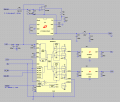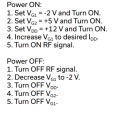Hello ,I got this good QORVO manual shown below it uses a combination of regulators and a comporator.
all the component there are analog
LT1716 -analog comparator
LTC1261LCS8-4 - negative generator
LT1761-BYP- analog regulator
Could you reccomend me names of similar components which could do the same method using a microcontroller?
Thanks.
https://www.qorvo.com/products/d/da007774
https://www.analog.com/en/resources/technical-articles/power-supply-sequencing-simplified.html
https://www.minicircuits.com/pdfs/PMA5-83-2W-D+.pdf
https://www.qorvo.com/products/d/da007774

all the component there are analog
LT1716 -analog comparator
LTC1261LCS8-4 - negative generator
LT1761-BYP- analog regulator
Could you reccomend me names of similar components which could do the same method using a microcontroller?
Thanks.
https://www.qorvo.com/products/d/da007774
https://www.analog.com/en/resources/technical-articles/power-supply-sequencing-simplified.html
https://www.minicircuits.com/pdfs/PMA5-83-2W-D+.pdf
https://www.qorvo.com/products/d/da007774

Attachments
-
3.7 KB Views: 8
Last edited:













